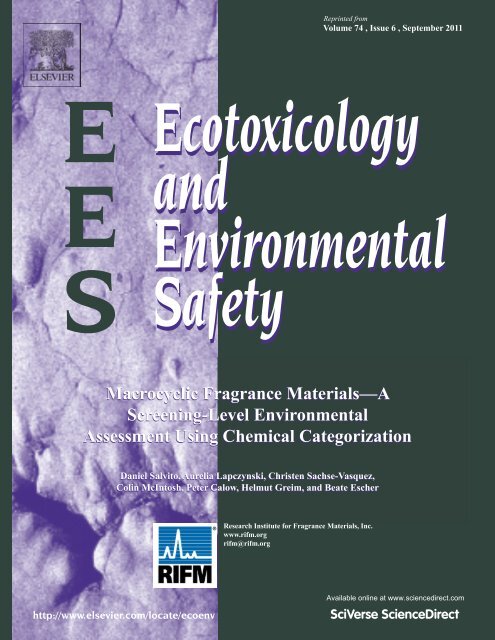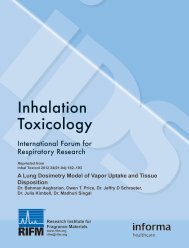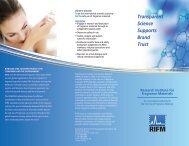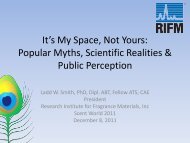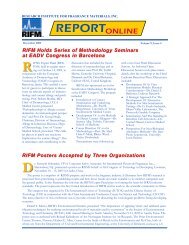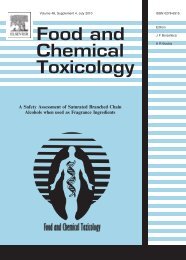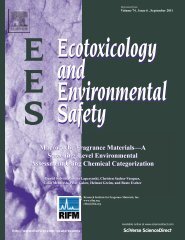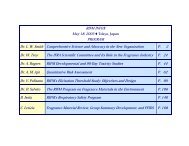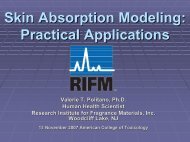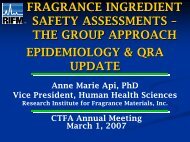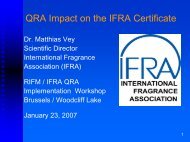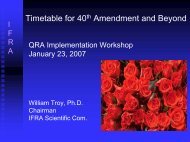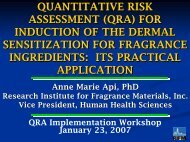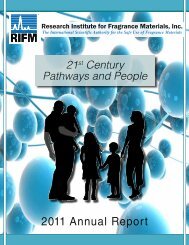to download - Research Institute for Fragrance Materials
to download - Research Institute for Fragrance Materials
to download - Research Institute for Fragrance Materials
Create successful ePaper yourself
Turn your PDF publications into a flip-book with our unique Google optimized e-Paper software.
EES_4C_EES 10/6/11 12:59 PM Page 1<br />
Reprinted from<br />
Volume 74 , Issue 6 , September 2011<br />
E<br />
E<br />
S<br />
Eco<strong>to</strong>xicology<br />
and<br />
Environmental<br />
Safety<br />
Macrocyclic <strong>Fragrance</strong> <strong>Materials</strong>—A<br />
Screening-Level Environmental<br />
Assessment Using Chemical Categorization<br />
Daniel Salvi<strong>to</strong>, Aurelia Lapczynski, Christen Sachse-Vasquez,<br />
Colin McIn<strong>to</strong>sh, Peter Calow, Helmut Greim, and Beate Escher<br />
<strong>Research</strong> <strong>Institute</strong> <strong>for</strong> <strong>Fragrance</strong> <strong>Materials</strong>, Inc.<br />
www.rifm.org<br />
rifm@rifm.org<br />
http://www.elsevier.com/locate/ecoenv
No responsibility is assumed by Elsevier, its licensors or associates <strong>for</strong> any injury and/or damage <strong>to</strong> persons or property as a matter of products<br />
liability, negligence or otherwise, or from any use or operation of any methods, products, instructions, or ideas contained in the material herein.<br />
Because of rapid advances in the medical sciences, in particular, independent verification of diagnoses and drug dosages should be made.<br />
Eco<strong>to</strong>xicology and Environmental Safety 74 (2011) 1619–1629<br />
Contents lists available at ScienceDirect<br />
Eco<strong>to</strong>xicology and Environmental Safety<br />
journal homepage: www.elsevier.com/locate/ecoenv<br />
Macrocyclic fragrance materials—A screening-level environmental<br />
assessment using chemical categorization<br />
Daniel Salvi<strong>to</strong> a,n , Aurelia Lapczynski a , Christen Sachse-Vasquez b , Colin McIn<strong>to</strong>sh c , Peter Calow d ,<br />
Helmut Greim e , Beate Escher f<br />
a <strong>Research</strong> <strong>Institute</strong> <strong>for</strong> <strong>Fragrance</strong> <strong>Materials</strong>, 50 Tice Boulevard, Woodcliff Lake, NJ 07677, USA<br />
b Takasago International Corporation, Rockleigh, NJ, USA<br />
c Firmenich, Inc. Prince<strong>to</strong>n, NJ, USA<br />
d Roskilde University, Department of Environmental, Social & Spatial Change, Roskilde, Denmark<br />
e Technical University of Munich, <strong>Institute</strong> <strong>for</strong> Toxicology & Environmental Hygiene, Freising-Weihenstephan, Germany<br />
f University of Queensland, National <strong>Research</strong> Centre <strong>for</strong> Environment Toxicology (EnTox), Coopers Plains, Australia<br />
article info<br />
Article his<strong>to</strong>ry:<br />
Received 15 December 2010<br />
Received in revised <strong>for</strong>m<br />
4 May 2011<br />
Accepted 5 May 2011<br />
Available online 12 June 2011<br />
Keywords:<br />
Risk assessment<br />
Chemical categorization<br />
<strong>Fragrance</strong> ingredients<br />
abstract<br />
A screening-level aquatic environmental risk assessment <strong>for</strong> macrocyclic fragrance materials using a<br />
‘‘group approach’’ is presented using data <strong>for</strong> 30 macrocyclic fragrance ingredients. In this group<br />
approach, conservative estimates of environmental exposure and eco<strong>to</strong>xicological effects thresholds <strong>for</strong><br />
compounds within two subgroups (15 macrocyclic ke<strong>to</strong>nes and 15 macrocyclic lac<strong>to</strong>nes/lactides) were<br />
used <strong>to</strong> estimate the aquatic ecological risk potential <strong>for</strong> these subgroups. It is reasonable <strong>to</strong> separate<br />
these fragrance materials in<strong>to</strong> the two subgroups based on the likely metabolic pathway required <strong>for</strong><br />
biodegradation and on expected different eco<strong>to</strong>xicological modes of action. The current volumes of use<br />
<strong>for</strong> the macrocyclic ke<strong>to</strong>nes in both Europe and North America ranges from o1 (low kg quantities) <strong>to</strong> no<br />
greater than 50 metric <strong>to</strong>nnes in either region and <strong>for</strong> macrocyclic lac<strong>to</strong>nes/lactides the volume of use<br />
range <strong>for</strong> both regions is o1 <strong>to</strong> no greater than 1000 metric <strong>to</strong>nnes in any one region. Based on these<br />
regional <strong>to</strong>nnages, biodegradability of these two subgroups of materials, and minimal in stream dilution<br />
(3:1), the conservatively predicted exposure concentrations <strong>for</strong> macrocyclic ke<strong>to</strong>nes would range from<br />
o0.01 <strong>to</strong> 0.05 mg/L in Europe and from o0.01 <strong>to</strong> 0.03 mg/L in North America. For macrocyclic lac<strong>to</strong>nes/<br />
lactides, the concentration within the mixing zone would range from o0.01 <strong>to</strong> 0.7 mg/L in Europe and<br />
from o0.01 <strong>to</strong> 1.0 mg/L in North America. The PNECs derived <strong>for</strong> the macrocyclic ke<strong>to</strong>nes is 0.22 mg/L<br />
and <strong>for</strong> macrocyclic lac<strong>to</strong>nes/lactides is 2.7 mg/L. The results of this screening-level aquatic ecological<br />
risk assessment indicate that at their current <strong>to</strong>nnage, often referred <strong>to</strong> as volumes of use, macrocyclic<br />
fragrance materials in Europe and North America, pose a negligible risk <strong>to</strong> aquatic biota; with no PEC/<br />
PNEC ratio exceeding 1 <strong>for</strong> any material in any subgroup.<br />
& 2011 Elsevier Inc. All rights reserved.<br />
1. Introduction<br />
The <strong>Research</strong> <strong>Institute</strong> <strong>for</strong> <strong>Fragrance</strong> <strong>Materials</strong> (RIFM) ‘‘Framework<br />
<strong>for</strong> prioritizing fragrance materials <strong>for</strong> aquatic risk assessment’’<br />
(termed ‘‘Environmental Framework’’ hereafter) was developed <strong>to</strong><br />
screen a large database of organic compounds used as fragrance<br />
ingredients <strong>to</strong> assess their potential environmental risk and set<br />
priorities <strong>for</strong> further risk assessment, as necessary (Salvi<strong>to</strong> et al.,<br />
2002). RIFM has been using a group or chemical categories approach<br />
based on structure–activity relationships <strong>for</strong> the assessment of<br />
human health safety (Bickers et al., 2003). Presented here is the first<br />
n Corresponding author.<br />
E-mail address: dsalvi<strong>to</strong>@rifm.org (D. Salvi<strong>to</strong>).<br />
0147-6513/$ - see front matter & 2011 Elsevier Inc. All rights reserved.<br />
doi:10.1016/j.ecoenv.2011.05.002<br />
application of this group approach <strong>for</strong> the aquatic risk assessment of<br />
structurally related groups of fragrance ingredients using the example<br />
of macrocyclic fragrance ingredients. Macrocyclic fragrance materials<br />
are important fragrance ingredients and are widely used in cosmetics,<br />
detergents, fabric softeners, cleaning products and other household<br />
products.Thisapproachisbasedonthehypothesisthatifchemicals<br />
are structurally related, they behave similarly in the aquatic environment.<br />
In the group approach, available environmental fate and effects<br />
values <strong>for</strong> individual compounds within the group are used <strong>to</strong><br />
conservatively estimate the potential <strong>for</strong> aquatic ecological risks <strong>for</strong><br />
the entire structurally related group. The fragrance materials in the<br />
macrocyclic ke<strong>to</strong>ne group and the macrocyclic lac<strong>to</strong>ne and lactide<br />
group have been reviewed in separate human health group summaries<br />
(Belsi<strong>to</strong> et al., in press a, b). These group summaries contain<br />
references <strong>to</strong> the <strong>Fragrance</strong> Material Reviews that provide the human<br />
health data <strong>for</strong> each of the individual materials in the group.
1620<br />
D. Salvi<strong>to</strong> et al. / Eco<strong>to</strong>xicology and Environmental Safety 74 (2011) 1619–1629<br />
1.1. Principles of chemical categorization<br />
Chemical categorization, also referred <strong>to</strong> as ‘‘chemical grouping’’,<br />
is a method of identifying analogs <strong>for</strong> chemicals of interest<br />
and enabling the extrapolation of a specific endpoint(s) of datapoor<br />
chemicals from data rich chemicals. Analogs can be readacross<br />
one chemical <strong>to</strong> one chemical, one <strong>to</strong> many, or many <strong>to</strong><br />
many. The OECD has established guidance on the <strong>for</strong>mation of<br />
categories and guidance has also been prepared in preparation <strong>for</strong><br />
REACH by a REACH Implementation Project (OECD, 2005).<br />
1.2. General guidelines<br />
The group approach as applied here followed the guidance<br />
provided by the OECD (OECD, 2005) <strong>for</strong> the <strong>for</strong>mation of chemical<br />
categories. This guidance could be applied <strong>to</strong> both human health<br />
and environmental endpoints. The principles are:<br />
1. Identify chemical category and assign its members.<br />
2. Gather published and unpublished data <strong>for</strong> each category<br />
member.<br />
3. Evaluate available data <strong>for</strong> adequacy in assessing the domain<br />
hypothesis.<br />
4. Construct a matrix of data availability.<br />
5. Per<strong>for</strong>m an internal assessment of the category.<br />
6. Prepare a category test plan.<br />
7. Conduct the necessary testing.<br />
8. Per<strong>for</strong>m an external assessment of the category and fill data gaps.<br />
The key steps <strong>for</strong> establishing a hypothesis and determining<br />
the validity of the hypothesis are steps 1 and 5; supported by the<br />
data gathering and review steps (2 through 4). Step 1 identifies<br />
the potential domain of the category and establishes the hypothesis<br />
built upon said domain. In a general sense a group of organic<br />
chemicals containing similar functional groups and covering a<br />
specified physical–chemical property range, potentially linked<br />
metabolically, should have endpoints that are predictive based<br />
on the findings of other members within the category.<br />
The purpose of Step 5 is <strong>to</strong> test the hypothesis <strong>for</strong>mulated in<br />
Step 1; i.e. trying <strong>to</strong> refute its premise that the group selected is a<br />
reasonable one <strong>for</strong> read-across. This is done using the existing<br />
in<strong>for</strong>mation and, assessing in parallel persistence (P), bioaccumulation<br />
(B) and <strong>to</strong>xicity (T) criteria. This part of the analysis will<br />
involve a more careful consideration of structure, QSAR and<br />
metabolic pathways than in Step 1. For example, the endpoints<br />
should support the metabolic pathway hypothesis and/or fit a<br />
well-validated QSAR. The possible outcomes of Step 5 are:<br />
Reject the entire category (should occur rarely).<br />
Reject some members based on sound scientific reasoning—<br />
poor fit with remaining members (expected outcome).<br />
Develop candidate subcategories ( note that the outcome here may<br />
be hierarchal; e.g. a ‘‘P’’ group with 2 different ‘‘BT’’ subgroups).<br />
Subcategory size should be the largest possible group of<br />
chemicals that shows common features (i.e., supports the domain<br />
hypothesis). However, the category itself may be the best fit <strong>for</strong><br />
all endpoints (i.e., no need <strong>for</strong> subcategorization).<br />
At this point there is likely <strong>to</strong> be a need <strong>for</strong> the collection of<br />
more data (Steps 6–8) <strong>for</strong> at least two purposes. To further test<br />
the hypothesis that the category is a sound one and <strong>to</strong> fill<br />
important data gaps.<br />
The following points have <strong>to</strong> be considered during the process:<br />
Categorization and its associated hypothesis testing is a weight<br />
of evidence approach. There are likely <strong>to</strong> be outliers that should<br />
fit the category but do not. To the extent possible, these<br />
outliers should be explained; e.g., a, b unsaturation with<br />
respect <strong>to</strong> carbonyl groups present is a different category that<br />
is not part of the general group of ke<strong>to</strong>nes.<br />
Categorization is an approach in which both the favorable and<br />
unfavorable aspects of available data are applied equally.<br />
The use of chemical categories does not preclude minimal<br />
testing strategies (i.e., minimally, physical–chemical properties<br />
have <strong>to</strong> be measured or estimated and ready biodegradation<br />
studies will need <strong>to</strong> be per<strong>for</strong>med).<br />
Subcategories <strong>for</strong> different endpoints may not match between<br />
endpoints relevant <strong>for</strong> human health and environmental endpoints<br />
(or even within); e.g., a skin sensitization subcategory<br />
may not contain all the same members as a persistence<br />
subcategory.<br />
Consideration of consistency between categories is important<br />
as well. There will be chemicals that will reside in more than<br />
one category. The development of the domain parameters and<br />
the category hypothesis should be applicable <strong>for</strong> the chemical<br />
in both (or more) categories. Furthermore, the conclusions <strong>for</strong><br />
the appropriate subcategories, in this case where a chemical<br />
would reside in two distinct groups, should be consistent (e.g.,<br />
the chemical cannot be bioaccumulative in one subcategory<br />
and not bioaccumulative in another).<br />
1.3. Specific guidelines <strong>for</strong> endpoint assessment in categorization<br />
While the principles outlined above provide guidance <strong>for</strong> the<br />
building and assessment of chemical categories in a broad sense,<br />
below are additional guidance <strong>for</strong> evaluating specific endpoints<br />
<strong>for</strong> environmental exposure (persistence and bioaccumulation<br />
data) and aquatic effects.<br />
1.3.1. Persistence<br />
If no experimental data are available the following computational<br />
models can serve as assessment <strong>to</strong>ols:<br />
(a) CATABOL—<strong>for</strong> commonality of metabolic pathways;<br />
(b) METEOR—<strong>for</strong> mammalian metabolism; may be useful <strong>for</strong> P<br />
assessment and <strong>for</strong> fish metabolism;<br />
(c) University of Minnesota Biocatalysis/Biodegradation<br />
Database—<strong>for</strong> degradation reaction pathways.<br />
The following questions need <strong>to</strong> be addressed:<br />
1. Structural assessment: Does the same path exist <strong>for</strong> the<br />
chemicals in the groups <strong>for</strong> initial primary degradation (same<br />
sites of attack)?<br />
2. Are there breaks in the available dataset between readily<br />
biodegradable materials, inherently biodegradable materials,<br />
and non-biodegradable materials that are structurally defined?<br />
3. Structural assessment: Is the pathway <strong>for</strong> biodegradation likely<br />
<strong>to</strong> go <strong>to</strong> completion (mineralization) or are there structural<br />
biophobes that are likely <strong>to</strong> inhibit this process?<br />
4. Do potential metabolites (i.e., breakdown products), of the<br />
chemicals that do not completely metabolize have B or T<br />
properties?<br />
5. What is the expectation of per<strong>for</strong>mance in a ready test (should<br />
be able <strong>to</strong> predict % biodegradation)?<br />
6. If no ready biodegradation is predicted:<br />
(a) Is the material <strong>to</strong>xic under test conditions?<br />
(b) Do organisms have difficulty growing on the chemical <strong>to</strong><br />
permit primary degradation (i.e., co-metabolism)?<br />
(c) Is the material bioavailable?<br />
(d) What is expected in aerobic versus anaerobic tests?
D. Salvi<strong>to</strong> et al. / Eco<strong>to</strong>xicology and Environmental Safety 74 (2011) 1619–1629 1621<br />
1.3.2. Bioaccumulation<br />
In a first step, the materials are grouped in classes with known<br />
metabolic activity versus non- or poorly metabolized materials.<br />
For non (poorly)-metabolizable chemicals separations between<br />
non-B/B/vB is based on the hydrophobicity indica<strong>to</strong>r octanol–<br />
water partition coefficient K OW ;<br />
For categories with more than one metabolic pathway, separate<br />
by pathway.<br />
1.3.3. Eco<strong>to</strong>xicity<br />
The classes are separated via mode of action (MOA) classification.<br />
For fragrance materials this separation is largely between<br />
narcosis (both Type I and II) and reactive <strong>to</strong>xicants (e.g., aldehydes).<br />
These mode-of-action classifications were originally<br />
proposed by Verhaar et al. (1992) and have had wide application<br />
in eco<strong>to</strong>xicology. MOA I and II (nonpolar and polar narcosis)<br />
chemicals can more than likely be grouped <strong>to</strong>gether as they have<br />
a common underlying mechanism (Vaes et al., 1998). The difference<br />
is not very significant. ECETOC developed a more robust<br />
method <strong>for</strong> determining MOA (Thomas et al., 2008) beyond the<br />
use of the structural alerts of Verhaar et al. (1992).<br />
This weight of evidence approach, in whole or in part, may<br />
prove useful in categorizing <strong>for</strong> eco<strong>to</strong>xic endpoints.<br />
2. <strong>Materials</strong> and methods<br />
identified in this study are a complete list of macrocyclic fragrance materials, as of<br />
this publication, used in commerce and found in the RIFM Database. The process<br />
described above <strong>for</strong> defining and assessing chemical categories was adhered <strong>to</strong>.<br />
Both of these classes are represented by a large carbon ring (typically 14–17<br />
carbons, Fig. 1). Unsaturation may also be present on the carbon ring. From the<br />
domain assessment that follows and a review of the available data, the presence or<br />
absence of unsaturation in the ring does not appear <strong>to</strong> necessitate further<br />
differentiation of these subgroups (i.e., there is no apparent effect on biodegradation<br />
or <strong>to</strong>xicity <strong>for</strong> these chemicals). The macrocyclic ke<strong>to</strong>nes contain only a single<br />
carbonyl functional group on the ring. The macrocyclic lac<strong>to</strong>nes/lactides contains<br />
one or two cyclic ester functional groups and, in the case of the lac<strong>to</strong>nes may also<br />
contain an additional ring oxygen or carbonyl group. Thirty different macrocyclic<br />
compounds were included in this group assessment, 15 lac<strong>to</strong>nes/lactides and 15<br />
ke<strong>to</strong>nes. Their physical–chemical properties are presented in Table 1. Measured<br />
data are provided where available. When measured values were not available,<br />
physical–chemical property estimates were calculated using the USEPA’s EPI Suite<br />
models (version 4.0).<br />
2.1.2. Microbial metabolism<br />
2.1.2.1. Gather published and unpublished data <strong>for</strong> each category member; evaluate<br />
available data <strong>for</strong> adequacy; construct a matrix of data availability. In addition <strong>to</strong> the<br />
structural differences between the two chemical classes, the macrocyclic ke<strong>to</strong>nes<br />
would have <strong>to</strong> undergo oxidation <strong>to</strong> a lac<strong>to</strong>ne during biodegradation and then<br />
further degrade via ester hydrolysis. The materials in the lac<strong>to</strong>ne/lactide subgroup<br />
would, there<strong>for</strong>e, degrade directly via ester hydrolysis. This microbial pathway<br />
was identified using the University of Minnesota Biocatalysis/Biodegradation<br />
Database (Gao et al., 2010) and shows, <strong>for</strong> cyclohexanone, Baeyer–Villiger oxidation<br />
of a cyclic ke<strong>to</strong>ne <strong>to</strong> a cyclic lac<strong>to</strong>ne (neutral under aerobic conditions)<br />
followed by the lac<strong>to</strong>ne <strong>for</strong>ming the hydroxy carboxylate (likely under aerobic<br />
conditions). A representative reaction pathway is shown in Fig. 2.<br />
2.1. Domain definition: macrocyclic fragrance ingredients<br />
2.1.1. Structural similarity and physical–chemical properties (identify chemical<br />
category and assign its members)<br />
These macrocyclic fragrance materials are important fragrance ingredients<br />
and are widely used in cosmetics, detergents, fabric softeners, cleaning products<br />
and other household products. The groups of macrocyclic fragrance ingredients<br />
identified <strong>for</strong> this study consist of two structural classes (i.e., subcategories),<br />
macrocyclic ke<strong>to</strong>nes and macrocyclic lac<strong>to</strong>nes/lactides. The materials specifically<br />
2.1.2.2. Per<strong>for</strong>m an internal assessment of the category. The two principally different<br />
pathways are supported by the difference in biodegradation predicted by BIOWIN<br />
<strong>for</strong> the two classes (i.e., predict ‘‘not readily biodegradable’’ <strong>for</strong> the ke<strong>to</strong>nes and<br />
‘‘readily biodegradable’’ <strong>for</strong> the lac<strong>to</strong>nes/lactides). This difference in prediction by<br />
the BIOWIN model is likely due <strong>to</strong> the necessity of an initial oxidation step <strong>for</strong> the<br />
ke<strong>to</strong>nes as noted above. Standardized experimental studies of biodegradation may<br />
not necessarily provide the data needed <strong>to</strong> demonstrate this difference. Thus, based<br />
on a weight of evidence approach, the biodegradation data <strong>for</strong> both groups of<br />
materials indicates that these compounds are readily biodegradable. However, the<br />
O<br />
O<br />
O<br />
Fig. 1. Domain definition.
1622<br />
D. Salvi<strong>to</strong> et al. / Eco<strong>to</strong>xicology and Environmental Safety 74 (2011) 1619–1629<br />
Table 1<br />
Physical chemical properties.<br />
CAS# Name 2008 Vol Global 2008 Vol EU 2008 Vol NA MW Formula K OW Solubility<br />
(aq) (mg/L)<br />
Vapor pressure<br />
(mm Hg 25 1C)<br />
Ke<strong>to</strong>nes<br />
542-46-1 9-Cycloheptadecen-1-one o1 o1 o1 250.43 C 17 H 30 O 6.31 0.096 0.00034<br />
2550-52-9 Cyclohexadecanone 1–10 1–10 1–10 238.41 C 16 H 30 O 6.04 0.19 0.00026<br />
2550-59-6 7-Cyclohexadecen-1-one o1 NR o1 236.4 C 16 H 28 O 5.82 0.30 0.00024<br />
37609-25-9 5-Cyclohexadecen-1-one 10–100 10–100 1–10 236.99 C16H28O 5.82 0.30 0.00024<br />
3100-36-5 Cyclohexadec-8-en-1-one mixture of cis and trans isomer 10–100 10–100 1–10 236.99<br />
502-72-7 Cyclopentadecanone 10–100 10–100 10–100 224.39 C 15 H 28 O 5.55 0.60 0.00042<br />
63314-79-4 5-Cyclopentadecen-1-one, 3-methyl- 1–10 NR 1–10 236.4 C 16 H 28 O 6.57 (m) 0.100 (m) 0.0003 (m)<br />
35720-57-1 4-Cyclopentadecen-1-one 1–10 1–10 NR 222.37 C 15 H 26 O 5.33 0.94 0.00057<br />
14595-54-1 4-Cyclopentadecen-1-one, (Z)- 1–10 o1 1–10<br />
3603-99-4 Cyclotetradecan-1-one 0 0 0 210.61 C 14 H 26 O 5.05 1.87 0.0016<br />
259854-70-1 5-Cyclotetradecen-1-one, 3-methyl-,(5E)- 1–10 o1 o1 222.37 C15H26O 5.6 (m) 1.08 0.0011<br />
259854-71-2 5-Cyclotetradecen-1-one, 3-methyl-, (5Z)- NR NR NR<br />
541-91-3 3-Methyl-1-cyclopentadecanone 1–10 1–10 o1 238.42 C 16 H 30 O 5.96 0.22 0.00047<br />
82356-51-2 3-Methylcyclopentadecenone 10–100 10–100 10–100 C 16 H 28 O 44.88 (m) 0.899 (m) a 0.0003 (m)<br />
61415-11-0 3-Methylcyclotridecan-1-one NR NR NR 210.61 C 14 H 26 O 4.98 2.16 0.0021<br />
Lac<strong>to</strong>nes/lactides<br />
105-95-3 Ethylene brassylate 41000 100–1000 100–1000 270.37 C 15 H 26 O 4 4.7 (m) 1.72 4.4e 007<br />
54982-83-1 Ethylene dodecanedioate 100–1000 100–1000 100–1000 256.35 C14H24O4 3.65 (m) 75 (m) 0.00021 (m)<br />
109-29-5 Hexadecanolide 10–100 10–100 10–100 254.42 C16H30O2 6.65 0.047 2.5e 005<br />
7779-50-2 o-6-Hexadecenlac<strong>to</strong>ne o1 o1 o1 252.4 C 16 H 28 O 2 5.51 (m); 6.7 (m) –out<br />
of method range<br />
0.59 2.2e 005<br />
123-69-3 16-Hydroxy-7-hexadecenoic acid lac<strong>to</strong>ne o1 NR o1 252.39 C 16 H 28 O 2<br />
28645-51-4 Oxacycloheptadec-10-ene-2-one 10–100 10–100 10–100 252.39 C 16 H 28 O 2<br />
36508-31-3 Oxacycloheptadec-11-en-2-one o1 o1 o1 252.39 C 16 H 28 O 2<br />
38223-29-9 Oxacyclohexadecane-2,13-dione o1 o1 o1 254.37 C15H26O3 4.1 80 (m) 0.0006 (m)<br />
34902-57-3 Oxacyclohexadecen-2-one 100–1000 100–1000 100–1000 238.37 C15H26O2 46.2 (m); 43.94 (m);<br />
4.88 calc<br />
0. 964 (m) 0.0012 (m)<br />
111879-80-2 E- and Z-Oxacyclohexadec-12(þ13)-en-2-one 10–100 10–100 10–100<br />
329925-33-9 Oxacyclopentadec-10-en-2-one, 13-methyl- 1–10 1–10 1–10 238.37 C 15 H 26 O 2 2 isomers 5.8; 6.0 (m) 2.15 7.0 e 5<br />
1725-01-5 10-Oxahexadecanolide 1–10 o1 1–10 256.39 C 15 H 28 O 3 4.9 1.43 1.6e 005<br />
3391-83-1 11-Oxahexadecanolide 1–10 1–10 o1 256.39 C 15 H 28 O 3 4.9 1.43 1.6e 005<br />
6707-60-4 12-Oxahexadecanolide 1–10 1–10 o1 256.39 C15H28O3 4.9 1.43 1.6e 005<br />
106-02-5 o-Pentadecalac<strong>to</strong>ne 100–1000 100–1000 100–1000 240.39 C15H28O2 6.15 0.15 5.17e 005<br />
Properties calculated using EPISUITE 4.0 unless noted as measured: m.<br />
Volume range is in metric <strong>to</strong>nes.<br />
As several of these materials are structural isomers, the physical–chemical properties <strong>for</strong> isomers are grouped and only one value is reported.<br />
NR: None reported.<br />
a pH of 6.3 and 20 1C; another study at pH of 9.15 and 20 1C reports a solubility of o0.07 mg/L.
D. Salvi<strong>to</strong> et al. / Eco<strong>to</strong>xicology and Environmental Safety 74 (2011) 1619–1629 1623<br />
O<br />
O<br />
O<br />
OH<br />
O-<br />
O<br />
Fig. 2. Representative reaction pathway <strong>for</strong> microbial metabolism of macrocyclic ke<strong>to</strong>nes and lac<strong>to</strong>nes.<br />
known difference in metabolism does support the distinction between the two<br />
subclasses (Table 2).<br />
2.1.3. Eco<strong>to</strong>xicological mode of action<br />
2.1.3.1. Gather published and unpublished data <strong>for</strong> each category member, evaluate<br />
available data <strong>for</strong> adequacy, construct a matrix of data availability. The aquatic<br />
<strong>to</strong>xicity data is summarized in Table 3.<br />
Note: References noted in Tables 2 and 3 represent a significant number of<br />
unpublished studies from the RIFM Database. The complete citations <strong>for</strong> these<br />
studies can be found in the Supplemental In<strong>for</strong>mation provided <strong>for</strong> this paper.<br />
2.1.3.2. Per<strong>for</strong>m an internal assessment of the category. According <strong>to</strong> Verhaar et al.’s<br />
(1992) rules <strong>for</strong> identifying eco<strong>to</strong>xicological mode of action <strong>for</strong> organic compounds,<br />
the ke<strong>to</strong>nes would likely act as non-polar narcotics (Type I) and the lac<strong>to</strong>nes/lactides<br />
as polar narcotics (Type II). As noted earlier, as there is little <strong>to</strong><br />
differentiate between these two modes of action, the measured aquatic <strong>to</strong>xicity<br />
varies little between the two subcategories. It can be noted, in support of this<br />
distinction, that the USEPA’s QSAR model ECOSAR differentiates between the two<br />
classes of compounds as well. ECOSAR applies the neutral organic QSAR <strong>to</strong> the<br />
ke<strong>to</strong>nes and the ester QSAR <strong>to</strong> the lac<strong>to</strong>nes/lactides. Furthermore, comparison<br />
between the output of this QSAR and measured <strong>to</strong>xicity values is not necessarily<br />
confirma<strong>to</strong>ry of correct classification of a chemical category. These QSARs both<br />
under and over predict <strong>to</strong>xicity compared with experimental results.<br />
2.1.4. Conclusion on chemical categories<br />
As noted in Section 2.1.2, the measured experimental data <strong>for</strong> these two<br />
subgroups, are likely not sensitive enough <strong>to</strong> differentiate between the additional<br />
oxidation step needed <strong>for</strong> biodegradation or <strong>for</strong> differences between Type I and<br />
Type II narcosis in aquatic <strong>to</strong>xicity. However, following the Guidelines <strong>for</strong><br />
categorization, the structural differences, microbial pathway <strong>for</strong> degradation,<br />
and eco<strong>to</strong>xicological modes of action support the hypothesis that the macrocyclic<br />
fragrance materials are separable in<strong>to</strong> two subcategories: ke<strong>to</strong>nes and lac<strong>to</strong>ines/<br />
lactides (Fig. 3). As this is an exercise in hypothesis testing, the data, in and of<br />
themselves, do not refute this hypothesis.<br />
2.2. Screening level risk assessment <strong>for</strong> the aquatic compartment<br />
2.2.1. Problem <strong>for</strong>mulation<br />
A screening-level risk assessment was per<strong>for</strong>med using the RIFM Environmental<br />
Framework (Salvi<strong>to</strong> et al., 2002). This framework includes problem <strong>for</strong>mulation,<br />
evaluation of exposure (via a conservative predicted environmental concentration<br />
based on each individual material’s continental <strong>to</strong>nnage) and eco<strong>to</strong>xicological effect<br />
(via a predicted no effect concentration based on the lowest aquatic <strong>to</strong>xicity<br />
endpoint measured <strong>for</strong> any one material within a subgroup, but applied <strong>to</strong> the<br />
whole subgroup) and risk characterization. The assessment was per<strong>for</strong>med <strong>for</strong> each<br />
group using data from all compounds in the group.<br />
2.2.2. Analysis—characterization of exposure: PEC<br />
The primary pathway by which fragrance materials can enter the environment<br />
during and after consumer use is as wastewater washed down drains (Salvi<strong>to</strong><br />
et al., 2002). A portion of the fragrance materials may volatilize <strong>to</strong> the atmosphere.<br />
The amount depends upon the type of consumer product the fragrance material is<br />
used in and the volatility of the fragrance compound. Another fraction will leave<br />
the household in the wastewater. Most wastewater is discharged <strong>to</strong> sewers that<br />
connect <strong>to</strong> wastewater treatment plants (WWTPs), and thus considering the <strong>to</strong>tal<br />
volume of use of the fragrance materials discharged <strong>to</strong> the wastewater is an<br />
appropriately conservative approach <strong>for</strong> a screening level risk assessment as<br />
described in the Framework (Salvi<strong>to</strong> et al., 2002) and is also consistent with the<br />
ERA guidelines <strong>for</strong> pharmaceuticals (EMEA, 2006).<br />
A typical WWTP includes primary treatment <strong>to</strong> remove solids and secondary<br />
treatment <strong>to</strong> remove dissolved and suspended organic matter. The most common<br />
type of secondary treatment is activated sludge. Removal of fragrance materials<br />
can involve sorption <strong>to</strong> sewage solids in primary and secondary treatment,<br />
biodegradation or biotrans<strong>for</strong>mation mainly during secondary treatment, and<br />
removal by clarification in the final clarifier be<strong>for</strong>e discharge <strong>to</strong> the aquatic<br />
environment. During conveyance in the sewer and treatment, some material can<br />
volatilize <strong>to</strong> the atmosphere. In addition, materials can be biodegraded, biotrans<strong>for</strong>med,<br />
and sorbed <strong>to</strong> the sludge within the sewer. <strong>Materials</strong> removed by sorption<br />
<strong>to</strong> the sludge in the WWTP may be incinerated, landfilled, or amended <strong>to</strong> soil.<br />
Material not removed in the WWTP is discharged <strong>to</strong> surface waters, where<br />
biotrans<strong>for</strong>mation and biodegradation can continue. In the surface waters,<br />
materials may sorb <strong>to</strong> suspended solids and be transferred <strong>to</strong> the sediments.<br />
Exposure is expressed as a PEC in the water column of the mixing zone, where<br />
WWTP effluent is diluted with surface water (e.g., stream or river). This<br />
concentration is determined by fragrance usage volume, removal during WWTP<br />
treatment, and dilution in the mixing zone (Salvi<strong>to</strong> et al., 2002). This approach<br />
makes the following assumptions: the entire fragrance usage volume in a region is<br />
discharged via sewers <strong>to</strong> WWTPs; usage is evenly distributed across the population<br />
of a region; no losses occur during consumer use or conveyance in the sewer<br />
as a result of volatilization or other processes; no losses occur as a result of<br />
biodegradation, biotrans<strong>for</strong>mation, or abiotic chemical processes; and effluents<br />
are minimally diluted (3:1) in the mixing zone. As noted in Salvi<strong>to</strong> et al. (2002) a<br />
3:1 dilution is a conservative dilution estimate especially relative <strong>to</strong> the 10:1<br />
dilution recommended in the technical guidance in Europe <strong>for</strong> local-scale<br />
exposure calculations (ECHA, 2008a). The assumptions used in estimating operational<br />
aspects of wastewater treatment are that wastewater undergoes primary<br />
and secondary (activated sludge) treatment, removal during sewage treatment<br />
occurs only as a result of sorption, removal of solids during primary treatment is<br />
only 50% (many plants exhibit better efficiency), the level of suspended solids in<br />
the aeration vessel of the activated sludge system is 2500 mg/L (<strong>for</strong> many plants<br />
this value is closer <strong>to</strong> 3500 mg/L), and the level of solids in final effluent is 20 mg/L<br />
(many plants have much lower solids levels in their effluents). This assessment<br />
depends on three input variables: regional usage volume (metric <strong>to</strong>ns/year),<br />
octanol–water partitioning coefficient (K OW ), and molecular weight. The model<br />
parameters and the conservative nature of this approach have been discussed<br />
elsewhere (Salvi<strong>to</strong> et al., 2002). Macrocyclic fragrance materials have estimated<br />
log K OW values ranging from about 4.2 <strong>to</strong> about 6.7. Molecular weights generally<br />
are around 250 g/mol (Table 1). Population differences, per capita water usage,<br />
and influent solid levels are the variants between scenarios <strong>for</strong> European and<br />
North American screening level exposure assessments (Salvi<strong>to</strong> et al., 2002).<br />
2.2.2.1. Calculation of the PEC. The PECs <strong>for</strong> all materials were estimated individually<br />
using the model described in the RIFM Environmental Framework (Salvi<strong>to</strong> et al.,<br />
2002) <strong>for</strong> the European and North American scenarios. For macrocyclic fragrance<br />
materials, the PEC was estimated based on the reported volume of use (IFRA, 2008) in<br />
Europe and North America, the individual material’s log K OW value, and a 3:1 dilution<br />
ratio <strong>to</strong> estimate exposure in the receiving stream. As the screening level assessment<br />
outlined in Salvi<strong>to</strong> et al. (2002) is able <strong>to</strong> incorporate measured biodegradation data<br />
when available, as is the case <strong>for</strong> both macrocyclic fragrance ingredient subgroups,<br />
this rate (1/h) was included in the analysis (Salvi<strong>to</strong> et al., 2002).<br />
2.2.3. Analysis—characterization of ecological effects: PNEC<br />
The potential <strong>to</strong>xic effects of a fragrance material in the aquatic environment<br />
were expressed in terms of a PNEC. All measured acute and chronic <strong>to</strong>xicity data<br />
available <strong>for</strong> each subgroup of compounds were evaluated and the lowest chronic<br />
no observed effect concentration (NOEC) <strong>for</strong> the subgroup was identified, based on<br />
measured concentrations. As data are not available <strong>for</strong> each compound in the<br />
particular subgroup, this NOEC was applied <strong>to</strong> all compounds within the subgroup<br />
<strong>to</strong> calculate risk quotients. This is consistent with using a ‘‘group approach’’. All of<br />
the <strong>to</strong>xicity tests were per<strong>for</strong>med using Organization <strong>for</strong> Economic Cooperation<br />
and Development (OECD) methods (OECD, 2006a) or similar methodologies and<br />
are noted in Table 3. The PNEC was estimated by dividing the lowest chronic NOEC<br />
by an assessment fac<strong>to</strong>r selected using European Union guidelines (ECHA, 2008b)<br />
and the RIFM Environmental Framework (Salvi<strong>to</strong> et al., 2002).<br />
2.2.3.1. Risk characterization. Potential risk <strong>to</strong> the aquatic environment <strong>for</strong> each<br />
subgroup was estimated from the ratio of the PEC <strong>to</strong> PNEC (PEC/PNEC) which
1624<br />
D. Salvi<strong>to</strong> et al. / Eco<strong>to</strong>xicology and Environmental Safety 74 (2011) 1619–1629<br />
Table 2<br />
Biodegradation summary.<br />
Material CAS# Method Test duration Results References<br />
(a) Ke<strong>to</strong>nes<br />
5-cyclohexadecen-1-one 37609-25-9 OECD 301B 28 days 81% and 83% RIFM (1996a)<br />
OECD 301C 26 days 52%, 60% and 68% RIFM (1997a)<br />
OECD 302C 28 days 60% RIFM (1997b)<br />
OECD 301F 28 days 86% RIFM (1997c)<br />
Cyclopentadecanone 502-72-7 OECD 302A 28 days 66.7% RIFM (1997d)<br />
4-cyclopentadecen-1-one, (Z)- 14595-54-1 OECD 301B 28 days 83.9% RIFM (1999a)<br />
OECD 302A 28 days 99.8% RIFM (1999b)<br />
3-Methylcyclopentadecenone 82356-51-2 OECD 301F 28 days 61% RIFM, 1996b<br />
OECD 301B 28 days 96.4% (10 mg/L) RIFM (1996c)<br />
93.4% (20 mg/L)<br />
OECD 301D 28 days 43% RIFM (1995a)<br />
SCAS 7 days 99.9% removal RIFM (1995b)<br />
OCED 301B 28 days 78.8% RIFM (2000a)<br />
OECD 302A 28 days 96.1% RIFM (2000b)<br />
OECD 302C 28 days 85% BOD; 100% GC RIFM (2000c)<br />
Cyclohexadecanone 2550-52-9 OECD 301B 28 days 43% RIFM, 2001a<br />
5-Cyclotetradecen-1-one, 3-methyl-<br />
259854-70-1 OECD 302C 28 days 75% RIFM (2004a)<br />
,(5E)<br />
OECD 301F 28 days 70% [73% after 34 days] RIFM (2004b)<br />
5-Cyclotetradecen-1-one, 3-methyl-<br />
,(5Z)<br />
259854-71-2 OECD 302C 28 days 75% RIFM, 2004a<br />
OECD 301F 28 days 70% [73% after 34 days] RIFM, 2004b<br />
3-Methyl-1-cyclopentadecanone 541-91-3 OECD 301F 28 days 80% RIFM (2009a)<br />
5-Cyclopentadecen-1-one, 3-methyl- 63314-79-4 OECD 301F 28 days 80% (100 mg/L); 81% (20 mg/L) RIFM (2009b)<br />
(b) Lac<strong>to</strong>nes/lactides<br />
Ethylene brassylate 105-95-3 ‘‘Closed Bottle’’ 28 days 40% RIFM (1996d)<br />
OECD 301F 28 days 73% RIFM (1996e)<br />
OECD 301F 28 days 77% RIFM (1996f)<br />
OECD 301F 28 days 89% RIFM (1998a)<br />
OECD 301B 28 days 78.1% RIFM (1994a)<br />
OECD 301F 28 days 83% RIFM (1999c)<br />
OECD 301C 28 days 85% BOD; 100% GC RIFM (1997e)<br />
OECD 301B 28 days 4100% RIFM (1997f)<br />
Ethylene dodecanedioate 54982-83-1 OECD 301B 28 days 80%; 78% RIFM (1997g)<br />
OECD 301C 28 days 73% BOD; 100% GC RIFM (1999d)<br />
OECD 301B 28 days 4100% RIFM (2000d)<br />
Oxacycloheptadec-10-ene-2-one 28645-51-4 OECD 301F 28 days 84% RIFM (1994b)<br />
Oxacycloheptadec-11-en-2-one 36508-31-3 OECD 301B 28 days 82% RIFM (1997h)<br />
10-Oxahexadecanolide 1725-01-5 OECD 301B 28 days 100% RIFM (1997i)<br />
11-Oxahexadecanolide 3391-83-1 OECD 301B 28 days 79.6% RIFM (1993)<br />
12-Oxahexadecanolide 6707-60-4 OECD 301B 28 days 96.5% RIFM (1996g)<br />
o-Pentadecalac<strong>to</strong>ne 106-02-5 OECD 301B 28 days 93% RIFM (1996h)<br />
OECD 301F 28 days 71% RIFM (2005)<br />
OECD 301B 28 days 82% RIFM (1998b)<br />
M.R Test C.4-D 28 days 90% RIFM (1996i)<br />
Oxacyclohexadecane-2,13-dione 38223-29-9 OECD 301B 28 days 83% (10 mg/L), 79% (20 mg/L) RIFM (1990a)<br />
E- and Z-Oxacyclohexadec-12(þ13)-<br />
111879-80-2 OECD 301F 28 days 95% RIFM (1996j)<br />
en-2-one<br />
OECD 301B 28 days 86.1% (10 mg/L); 87.1% (20 mg/L) RIFM (1995c)<br />
SCAS (SDA<br />
7 days Ave. removal: 95% RIFM (1995d)<br />
Method)<br />
OECD 301C 28 days 92% BOD; 100% GC RIFM, 1998c<br />
Oxacyclopentadec-10-en-2-one, 13-<br />
methyl<br />
Oxacyclopentadec-10-en-2-one, 13-<br />
methyl<br />
329925-33-9 OECD 111 120 h abiotic<br />
deg.<br />
(hydrolysis)<br />
0.4 mg/L<br />
329925-33-9 OECD 111 120 h abiotic<br />
deg.<br />
(hydrolysis)<br />
0.4 mg/L<br />
At pH values of 4 and 7 degradation is less than 10% after 5 days (equivalent <strong>to</strong> a<br />
half-life time higher than 1 year at 25 1C) and no more testing is required. For pH 9,<br />
about 50% degradation was observed after 120 h. In this case, a second degradation<br />
test was recommended at a lower temperature (35 1C)<br />
The low concentration measured at 120 h in the pH 7 solution is not in agreement<br />
with the results of the second preliminary test. An accidental loss during analysis<br />
may have occurred. The slow hydrolysis of the test material at pH 4 and 7, as<br />
observed at 50 1C is confirmed (half-life time higher than one year). Hydrolysis at<br />
pH 9 is slower than in the experiment at 50 1C, it also fits roughly a pseudo-first<br />
order law (straight line). From the two tests at 50 1C and 35 1C, a rate constant and<br />
half-life time at 25 1C can be calculated. The rate constant at 25 1C¼21.4 days<br />
RIFM (2000e)<br />
RIFM (2000e)<br />
OECD 301F 28 days 87%; 89% after 39 days RIFM (2000f)
D. Salvi<strong>to</strong> et al. / Eco<strong>to</strong>xicology and Environmental Safety 74 (2011) 1619–1629 1625<br />
Table 3<br />
Aquatic eco<strong>to</strong>xicity data.<br />
Material CAS# Method Test<br />
duration<br />
Species Results References<br />
(a) Ke<strong>to</strong>nes<br />
3- Methylcyclopentadecenone 82356-51-2 OECD 202 48 h Daphnia<br />
magna<br />
OECD 211 21 days Daphnia<br />
magna<br />
OECD 203 96 h Oncorhynchus<br />
mykiss<br />
OECD 201 72 h Scenedesmus<br />
subspicatus<br />
OECD 210: No<br />
dose response<br />
relationship—not<br />
used <strong>for</strong> RA: See<br />
Supplemental<br />
In<strong>for</strong>mation<br />
33 days Pimephales<br />
promelas<br />
Cyclohexadecanone 2550-52-9 OECD 202 48 h Daphnia<br />
magna<br />
5-Cyclotetradecen-1-one, 3-methyl-<br />
,(5E)<br />
5-Cyclotetradecen-1-one, 3-methyl-<br />
,(5Z)<br />
OECD 203: Conc<br />
based on initial<br />
conc; no material<br />
detected at study<br />
termination<br />
96 h Brachydanio<br />
rerio<br />
OECD 201 72 h Scenedesmus<br />
subspicatus<br />
259854-70-1 OECD 202 48 h Daphnia<br />
magna<br />
259854-71-2 OECD 202 48 h Daphnia<br />
magna<br />
5-Cyclopentadecen-1-one, 3-methyl- 63314-79-4 OECD 201 (ErC50<br />
was extrapolated<br />
<strong>to</strong> 754 mg/L;<br />
highest test conc.<br />
was 715 mg/L)<br />
OECD 211 (time<br />
weighted means)<br />
72 h Pseudokirchneriella<br />
subcapitata<br />
21 days Daphnia<br />
magna<br />
(b) Lac<strong>to</strong>nes/lactides<br />
Ethylene brassylate 105-95-3 OECD 202 48 h Daphnia<br />
magna<br />
OECD 203 96 h Brachydanio<br />
rerio<br />
OECD 202 21 day Daphnia<br />
magna<br />
67/548/EWT<br />
(Algae Inhibition<br />
Test)<br />
72 h Scenedesmus<br />
subspicatus<br />
Ethylene dodecanedioate 54982-83-1 OECD 202 48 h Daphnia<br />
magna<br />
OECD 203 96 h Oncorhynchus<br />
mykiss<br />
OECD 201 72 h Scenedesmus<br />
capricornutum<br />
EC50: 0.39 mg/L RIFM (1995e)<br />
NOEC: 0.18 mg/L<br />
EC50 (repro): 0.022 mg/L RIFM (2003a)<br />
LOEC: 0.045 mg/L: NOEC: 0.011 mg/L<br />
LC50: 0.45 mg/L RIFM (1995f)<br />
NOEC: 0.18 mg/L<br />
EbC50: 430 mg/L; ErC50: 430 mg/L; NOEC: Z30 mg/L RIFM (1995g)<br />
NOEC: 0.0020 mg/L (nominal) RIFM (2003b)<br />
0.00098 mg/L (mean measured)<br />
EC50:40.19 mg/L RIFM (2001b)<br />
LC50:40.1 mg/L RIFM (2001c)<br />
LC50: 40.22 mg/L<br />
EbC50: 41.8 mg/L; ErC50: 41.8 mg/L; NOEC: 41.8 mg/L RIFM (2001d)<br />
EC50: 0.58 mg/L RIFM (2004c)<br />
NOEC: 0.32 mg/L<br />
EC50: 0.58 mg/L RIFM (2004c)<br />
NOEC: 0.32 mg/L<br />
EbC50: 40.715 mg/L; RIFM (2009c)<br />
ErC50: 40.715 mg/L;<br />
NOEC: 0.371 mg/L<br />
EC50 (repro): 0.2534 mg/L RIFM (2009)<br />
LOEC: 0.1550 mg/L:<br />
NOEC: 0.0899 mg/L<br />
Geom. Mean EC0/EC100: 6.4 mg/L RIFM (1996k)<br />
Geom. Mean LC0/LC100: 1.23 mg/L RIFM (1996l)<br />
LOEC: 0.165 mg/L RIFM (1996m)<br />
NOEC: 0.088 mg/L<br />
EbC50: 5.2 mg/L; ErC50:46.9 mg/L; RIFM (1996n)<br />
NOEC: 3.48 mg/L<br />
EC50: 414 mg/L; NOEC: 14 mg/L RIFM (1997j)<br />
LC50: 0.88 mg/L; NOEC: 0.10 mg/L RIFM (1997k)<br />
EbC50: 1.9 mg/L; ErC50: 17 mg/L; RIFM (1997l)<br />
NOEC: 0.61 mg/L
1626<br />
D. Salvi<strong>to</strong> et al. / Eco<strong>to</strong>xicology and Environmental Safety 74 (2011) 1619–1629<br />
Table 3 (continued )<br />
Material CAS# Method Test<br />
duration<br />
Species Results References<br />
Oxacyclohepta dec-11-en-2-one 36508-31-3 OECD 202 48 h Daphnia<br />
magna<br />
o-Pentadeca lac<strong>to</strong>ne 106-02-5 (C.2), Directive<br />
67/548/EEC<br />
OECD 203 96 h Brachydanio<br />
rerio<br />
OECD 201 72 h Scenedesmus<br />
capricornutum<br />
(C.1) Directive 67/<br />
548/EEC<br />
48 h Daphnia<br />
magna<br />
96 h Brachydanio<br />
rerio<br />
OECD 202 21 days Daphnia<br />
magna<br />
(C.3), Directive<br />
67/548/EEC<br />
72 h Scenedesmus<br />
subspicatus<br />
Oxacyclohexa-decane-2,13-dione 38223-29-9 OECD 202 48 h Daphnia<br />
magna<br />
E- and Z-Oxacyclohexadec-12(þ13)-<br />
en-2-one<br />
E- and Z-Oxacyclohexa dec-12(þ13)-<br />
en-2-one<br />
Oxacyclopenta dec-10-en-2-one, 13-<br />
methyl<br />
OECD 202: 21 days Daphnia<br />
magna<br />
OECD 201 72 h Scenedesmus<br />
subspicatus<br />
OECD 203 96 h Cyprinus<br />
carpio<br />
111879-80-2 OECD 210 33 days Pimephales<br />
promelas<br />
111879-80-2 OECD 202 48 h Daphnia<br />
magna<br />
OECD 203 96 h Oncorhynchus<br />
mykiss<br />
OECD 202 21 days Daphnia<br />
magna<br />
OECD 201 72 h Scenedesmus<br />
subspicatus<br />
329925-33-9 OECD 202 48 h Daphnia<br />
magna<br />
OECD 203 96 h Cyprinus<br />
carpio<br />
OECD 201 72 h Selenastrum<br />
capricornutum<br />
EC50: 466 mg/l; RIFM (2000g)<br />
LC50: 42.5 mg/l; NOEC: 11.0 mg/l RIFM (2000h)<br />
EbC50 and ErC50:4113.5 mg/l; RIFM (1997m)<br />
EC0: 41.27 mg/L RIFM (1995h)<br />
LC0:40.11 mg/L RIFM (1994c)<br />
EC 0 / EC 100 (Immob; Geo Mean) 0.093 mg/L (0.28 mg/L (Nominal) RIFM,1996o<br />
EC 50 (Repro):40.068 mg/Lo0.127 mg/L [4 0.2 mg/Lo0.4 rng/l (Nominal)]<br />
NOEC (Repro) 0.068 rng/l [0.2 rng/l (Nominal)]<br />
LOEC (Repro): 0.127 rng/l [0.4 mg/L (Nominal)]<br />
NOEC: 0.26 mg/L: EbC50: 0.4 mg/L; ErC50: 40.47 mg/L RIFM (1996p)<br />
NOEC: 10 mg/L RIFM (1990b)<br />
EC50: 21.2 mg/L<br />
NOEC41.0 mg/L RIFM (1996q)<br />
EC50 41.0 mg/L<br />
EbC50: 11 mg/L; ErC50: 16 mg/L; RIFM (1994d)<br />
NOEC: 6.9 mg/L<br />
LC50: between 3.2 and 5.6 mg/L RIFM (1990e)<br />
NOEC: r1.8 mg/L<br />
NOEC: 0.027 mg/L (mean measured); 0.16 mg/L (nominal) RIFM ,(2003c)<br />
LOEC: 0.11 mg/L (mean measured); 0.50 mg/L (nominal)<br />
Nominal EC50: 0.88 mg/L RIFM (1995i)<br />
NOEC: 0.32 mg/L;<br />
Measured EC50: 0.48 mg/L<br />
NOEC: 0.24 mg/L<br />
Nominal LC50: 2.4 mg/L RIFM (1995j)<br />
NOEC: 1.0 mg/L;<br />
Measured LC50: 2.0 mg/L<br />
NOEC: 0.52 mg/L<br />
EC50 (immob): 0.27 mg/L, nominal; 0.079 mg/L, time-weighted mean measured<br />
EC50 (repro): 0.27 mg/L, nominal; 0.079 mg/L, time-weighted mean measured<br />
LOEC: 0.48 mg/L, nominal; 0.16 mg/L, time-weighted mean measured NOEC:<br />
0.15 mg/L, nominal; 0.039 mg/L, time-weighted mean measured<br />
RIFM (2002)<br />
EbC50: 2.4 mg/L; ErC50: 5.0 mg/L; NOEC: 0.625mg/L RIFM (1995k)<br />
EC50:40.686 mg/L RIFM (2001e)<br />
LC50: 40.884 mg/L RIFM (2001f)<br />
The NOEC corresponded with a WAF prepared at 10 mg/L <strong>for</strong> both cell growth<br />
inhibition and growth rate reduction. The NOEC exceeded the maximum solubility<br />
of 1.6 mg/L at 20 1C in distilled water and 0.6 mg/L at 20 1C and a pH of 7.0 in reconstituted<br />
medium<br />
RIFM (2001g)
D. Salvi<strong>to</strong> et al. / Eco<strong>to</strong>xicology and Environmental Safety 74 (2011) 1619–1629 1627<br />
Fig. 3. Decision process following categorization guidelines.<br />
defines the risk quotient. When the PEC/PNEC ratio is below one, the risk from the<br />
macrocyclic group is considered <strong>to</strong> be negligible at current volumes of use and<br />
thus no adverse aquatic impacts are expected. The screening-level risk assessment<br />
answers the question: ‘‘Is there a potential <strong>for</strong> ecological risk?’’. When the risk<br />
quotient exceeds one, a more robust assessment of the environmental risk is<br />
warranted <strong>to</strong> attempt <strong>to</strong> quantify the magnitude and probability of those risks.<br />
3. Results and discussion<br />
Read-across plays an important role in the risk assessment<br />
that follows. Following the guidance established in Section 1 of<br />
this paper, and having supported the hypothesis that these<br />
materials can be assessed as two groups of macrocyclic compounds,<br />
it is appropriate <strong>to</strong> read across from the data presented<br />
<strong>for</strong> both biodegradation and aquatic <strong>to</strong>xicity.<br />
3.1. Estimation of PECs—exposure assessment<br />
The annual volume of use range <strong>for</strong> the macrocyclic ke<strong>to</strong>nes in<br />
both Europe and North America is from o1 (low kg quantities) <strong>to</strong><br />
no greater than 50 metric <strong>to</strong>nnes in either region (resulting in the<br />
10–100 <strong>to</strong>nne <strong>to</strong>nnage band) and <strong>for</strong> macrocyclic lac<strong>to</strong>nes/lactides<br />
the volume of use range <strong>for</strong> both regions is o1 <strong>to</strong> no greater<br />
than 1000 metric <strong>to</strong>nnes in any one region; here, resulting in a<br />
41000 metric <strong>to</strong>nnes volume of use band (IFRA, 2008).<br />
Within the RIFM/FEMA Database there are 22 biodegradation<br />
studies available <strong>for</strong> 9 macrocyclic ke<strong>to</strong>nes and 28 studies <strong>for</strong> 11<br />
macrocyclic lac<strong>to</strong>nes/lactides (Table 2). Following OECD Guidelines<br />
(OECD, 2006b) <strong>for</strong> determining ready biodegradation (e.g.,<br />
considering the ‘‘10-day window’’), macrocyclic ke<strong>to</strong>nes range<br />
from inherent <strong>to</strong> readily biodegradable. However, the range of<br />
biodegradation (mineralization) from these studies ranges from a<br />
low of 43% <strong>to</strong> a high of 100%. In per<strong>for</strong>ming this assessment the<br />
quality of the data reported in the RIFM Database was evaluated.<br />
All studies followed OECD Guidelines. While data outliers are<br />
present, there was nothing present in the data reports <strong>to</strong> warrant<br />
their exclusion. There<strong>for</strong>e, all available biodegradation were used.<br />
The low values observed are not supported by the weight of<br />
evidence from the studies (see Table 2) evaluated <strong>for</strong> any<br />
individual compound but are included in this assessment <strong>for</strong><br />
completeness and <strong>to</strong> provide <strong>for</strong> a conservative evaluation of<br />
exposure. In applying the RIFM Framework, a conservative value<br />
of 1 h 1 is used as the biodegradation rate <strong>for</strong> these compounds.<br />
Macrocyclic lac<strong>to</strong>nes/lactides were largely found <strong>to</strong> be readily<br />
biodegradable with biodegradation ranging from 71% <strong>to</strong> 4100%<br />
in the available studies with a single outlier (40%) not supported<br />
by other studies <strong>for</strong> the same compound (ethylene brassylate). In<br />
applying the RIFM Framework, while a rate of 3 h 1 is acceptable,<br />
a conservative value of 1 h 1 was applied <strong>for</strong> biodegradation in<br />
the WWTP in the exposure assessment of these compounds.<br />
Based on these data, neither the macrocyclic ke<strong>to</strong>nes nor the<br />
macrocyclic lac<strong>to</strong>nes/lactides should be considered persistent in<br />
the aquatic environment.<br />
Based on these input parameters, and a 3:1 dilution ratio, the<br />
Framework estimates that the predicted concentration of macrocyclic<br />
ke<strong>to</strong>nes in river water within the mixing zone of the WWTP<br />
discharge would be range from o0.01 <strong>to</strong> 0.05 mg/L in Europe and<br />
from o0.01 <strong>to</strong> 0.03 mg/L in North America. For macrocyclic<br />
lac<strong>to</strong>nes/lactides, the concentration within the mixing zone<br />
would range from in Europe from o0.01 <strong>to</strong> 0.7 mg/L and from<br />
o0.01 <strong>to</strong> 1.0 mg/L in North America. These differences between<br />
regions occur because there are different input parameters <strong>for</strong> the
1628<br />
D. Salvi<strong>to</strong> et al. / Eco<strong>to</strong>xicology and Environmental Safety 74 (2011) 1619–1629<br />
model <strong>for</strong> Europe and North America (e.g., per capita water use)<br />
and <strong>to</strong>nnage varies between the two regions.<br />
3.2. Estimation of PNECs<br />
For 5 macrocyclics ke<strong>to</strong>nes, 3 algae inhibition studies, 4 daphnia<br />
immobilization studies, 2 fish acute lethality studies and 2 daphnia<br />
reproduction studies are available within the RIFM database. For<br />
7 macrocyclic lac<strong>to</strong>nes/lactides, 7 algae inhibition studies, 7 daphnia<br />
immobilization studies, 7 fish lethality studies, 4 daphnia<br />
reproduction studies and 1 fish early life stage study are available<br />
within the RIFM Database. For the ke<strong>to</strong>nes, and the lac<strong>to</strong>nes/<br />
lactides as well, eco<strong>to</strong>xicity studies are often difficult <strong>to</strong> per<strong>for</strong>m<br />
due <strong>to</strong> the poor solubility of the materials, their volatility, and<br />
their ability <strong>to</strong> degrade. Concerns about material solubility and the<br />
usefulness of the data do not negate the conservative nature of<br />
this assessment. In per<strong>for</strong>ming this assessment the quality of the<br />
data reported in the RIFM Database was evaluated. All studies<br />
followed OECD Guidelines. The chronic <strong>to</strong>xicity studies, run at<br />
lower concentrations below the water solubility, provide <strong>for</strong><br />
reliable data <strong>to</strong> be used in this group effects assessment. The acute<br />
data, while more prone <strong>to</strong> concerns about material solubility,<br />
appear <strong>to</strong> provide relatively consistent experimental values continuing<br />
<strong>to</strong> support the group effects assessment. In only one case, a<br />
Fish, Early Life Stage study of 3-methylcyclopentadecenone, was<br />
the data determined <strong>to</strong> be of sufficiently poor quality that it could<br />
not be used in this assessment (see Supplemental In<strong>for</strong>mation).<br />
These data are summarized in Table 3.<br />
For the macrocyclic ke<strong>to</strong>nes, the lowest acute EC 50 /LC 50 reported<br />
(algae, daphnia or fish) was 0.39 mg/L (D. magna immobilization<br />
study <strong>for</strong> 3-Methylcyclopentadecenone) and the lowest NOEC was<br />
0.011 mg/L (D. magna reproduction study <strong>for</strong> 3-Methylcyclopentadecenone).<br />
Two chronic endpoints are available (algae and daphnia),<br />
there<strong>for</strong>e an assessment fac<strong>to</strong>r of 50, as described in Salvi<strong>to</strong> et al.<br />
(2002) is applied <strong>to</strong> this NOEC. The PNEC derived <strong>for</strong> the macrocyclic<br />
ke<strong>to</strong>nesis0.22mg/L.<br />
For the macrocyclic lac<strong>to</strong>nes/lactides, the lowest acute EC 50 /LC 50<br />
reported (algae, daphnia or fish) was 0.0425 mg/L (Danio rerio<br />
lethality study <strong>for</strong> Oxacycloheptadec-11-en-2-one). This material<br />
is reported in other studies <strong>to</strong> be very poorly soluble (mean limit of<br />
solubility reported in its D. magna immobilization study is 66 mg/L).<br />
This may explain the difference observed in acute <strong>to</strong>xicity between<br />
this material and the other lac<strong>to</strong>nes/lactides where the next lowest<br />
acute endpoint reported is an order of magnitude higher (E b C 50 in<br />
an algae biomass based inhibition study <strong>for</strong> o-pentadecalac<strong>to</strong>ne).<br />
The lowest NOEC from a chronic <strong>to</strong>xicity study was 0.027 mg/L (fish<br />
early life stage study study <strong>for</strong> Oxacyclohexadecen-2-one). Three<br />
chronic endpoints are available (algae, daphnia, and fish), there<strong>for</strong>e<br />
an assessment fac<strong>to</strong>r of 10 is applied <strong>to</strong> this NOEC. The PNEC<br />
derived <strong>for</strong> the macrocyclic lac<strong>to</strong>nes/lactides is 2.7 mg/L.<br />
As with biodegradation, one rate applied <strong>to</strong> all chemicals<br />
within the subgroup, the PNEC is applied <strong>to</strong> all materials within<br />
each subgroup. Risk quotients are then calculated based on<br />
individual material PECs.<br />
3.3. Risk characterization<br />
The screening level risk quotient, PEC/PNEC ratio, <strong>for</strong> macrocyclic<br />
lac<strong>to</strong>nes/lactides ranges from o0.05 <strong>to</strong> 0.27 <strong>for</strong> the North<br />
American scenario and o0.05 <strong>to</strong> 0.35 <strong>for</strong> the European scenario<br />
identified in the RIFM Framework. The screening level PEC/PNEC<br />
ratio <strong>for</strong> macrocyclic ke<strong>to</strong>nes ranges from o0.05 <strong>to</strong> 0.14 <strong>for</strong> the<br />
North American scenario and o0.05 <strong>to</strong> 0.23 <strong>for</strong> the European<br />
scenario identified in the RIFM Framework (Figs. 4 and 5).<br />
Since the risk quotients <strong>for</strong> all materials are less than 1.0, the<br />
potential risks of macrocyclic fragrance ingredients <strong>to</strong> aquatic<br />
Fig. 4. Risk quotients <strong>for</strong> macrocyclic ke<strong>to</strong>nes categorized by volume bands<br />
(metric <strong>to</strong>nnes). Nine out of 15 materials are presented based on their EU <strong>to</strong>nnage<br />
and 9 out of 15 based on their US <strong>to</strong>nnage. Additional materials are not included as<br />
their risk quotients were <strong>to</strong>o low <strong>to</strong> be presented (50.01).<br />
Fig. 5. Risk quotients <strong>for</strong> macrocyclic lac<strong>to</strong>nes/lactides categorized by volume<br />
bands (metric <strong>to</strong>nnes). Seven out of 15 materials are presented based on their EU<br />
<strong>to</strong>nnage and 7 out of 15 based on their US <strong>to</strong>nnage. Additional materials are not<br />
included as their risk quotients were <strong>to</strong>o low <strong>to</strong> be presented (50.01).<br />
biota are negligible at current use levels. The RIFM Framework, as<br />
applied, has been designed <strong>to</strong> conservatively overpredict PEC/<br />
PNEC values. This screening-level assessment only evaluated the<br />
aqueous exposure pathway. It did not consider effects <strong>to</strong> sediment<br />
organisms or exposure via bioaccumulation in food.<br />
4. Conclusions<br />
The results of a screening-level aquatic ecological risk assessment<br />
using a group approach indicates that at the current volume<br />
of use, of macrocyclic fragrance materials do not pose a significant
D. Salvi<strong>to</strong> et al. / Eco<strong>to</strong>xicology and Environmental Safety 74 (2011) 1619–1629 1629<br />
risk <strong>to</strong> aquatic biota. This is primarily a function of the high<br />
degree of degradation expected in waste water treatment of<br />
macrocyclic fragrance materials resulting in efficient removal in<br />
wastewater treatment plants. Based on current volume of use, no<br />
PEC/PNEC ratio exceeds 1 <strong>for</strong> any material in any subgroup under<br />
any set of conditions identified in the RIFM Framework. The IFRA<br />
volume of use survey is revised every 4 years allowing RIFM <strong>to</strong><br />
reassess the aquatic risk of this class of fragrance materials.<br />
Acknowledgments<br />
The authors gratefully acknowledge the contributions<br />
Dr. Benjamin Parkhurst made <strong>to</strong> the development of this manuscript.<br />
The authors also acknowledge the <strong>Research</strong> <strong>Institute</strong> <strong>for</strong><br />
<strong>Fragrance</strong> <strong>Materials</strong> <strong>for</strong> their support of this project.<br />
Appendix A. Supplemental In<strong>for</strong>mation<br />
Supplementary data associated with this article can be found<br />
in the online version at doi:10.1016/j.ecoenv.2011.05.002.<br />
References<br />
Belsi<strong>to</strong>, D., Bickers, D., Bruze, M., Calow, P., Dagli, M., Fryer, A.D., Greim, H., Hanifin,<br />
J.H., Miyachi, Y., Saurat, J.H., Sipes, I.G., A <strong>to</strong>xicologic and derma<strong>to</strong>logic<br />
assessment of macrocylic ke<strong>to</strong>nes and derivatives when used as fragrance<br />
ingredients. Food and Chemical Toxicology, in press a.<br />
Belsi<strong>to</strong>, D., Bickers, D., Bruze, M., Calow, P., Dagli, M., Fryer, A.D., Greim, H., Hanifin,<br />
J.H., Miyachi, Y., Saurat, J.H., Sipes, I.G., A <strong>to</strong>xicologic and derma<strong>to</strong>logic<br />
assessment of macrocylic lac<strong>to</strong>nes and lactide derivatives when used as<br />
fragrance ingredients. Food and Chemical Toxicology, in press b.<br />
Bickers, D., Calow, P., Greim, H., Hanifin, J., Rogers, A., Saurat, J.H., Sipes, I., Smith,<br />
L., Tagami, H., 2003. The safety assessment of fragrance materials. Regula<strong>to</strong>ry<br />
Toxicology and Pharmacology 37 (2), 218–273.<br />
EMEA (European Medicine Agency), 2006. Guideline on the Environmental Risk<br />
Assessment of Medicinal Products <strong>for</strong> Human Use CHMP/SWP/4447/00. The<br />
European Agency <strong>for</strong> the Evaluation of Medicinal Products, London.<br />
ECHA (European Chemical Agency), 2008a. Guidance on In<strong>for</strong>mation Requirements<br />
and Chemical Safety Assessment Part E: Risk Characterization.<br />
European Chemicals Agency, Helsinki.<br />
ECHA (European Chemical Agency), 2008b. Guidance on In<strong>for</strong>mation Requirements<br />
and Chemical Safety Assessment Chapter R.10: Characterization of Dose<br />
[concentration]–response <strong>for</strong> Environment. European Chemicals Agency,<br />
Helsinki.<br />
Gao, J., Ellis, L., Wackett, L., 2010. The University of Minnesota Biocatalysis/<br />
Biodegradation Database: improving public access. Nucleic Acids <strong>Research</strong><br />
38, D488–D491.<br />
IFRA (International <strong>Fragrance</strong> Association), 2008. Volume of Use Survey.<br />
OECD (Organisation <strong>for</strong> Economic Cooperation and Development), 2005. Manual<br />
<strong>for</strong> investigation of HPV chemicals. Guidance on the Development and Use of<br />
Chemical Categories in the HPV Chemicals Programme (Chapter 3.2).<br />
OECD (Organisation <strong>for</strong> Economic Cooperation and Development), 2006a. OECD<br />
Guidelines <strong>for</strong> Testing of Chemicals, vol. 2. Section 2: Effects on Biotic Systems.<br />
Paris, France.<br />
OECD (Organisation <strong>for</strong> Economic Cooperation and Development), 2006b. OECD<br />
Guidelines <strong>for</strong> Testing of Chemicals, vol. 2. Section 3: Degradation and<br />
Accumulation. Paris, France.<br />
Salvi<strong>to</strong>, D., Senna, R., Federle, T., 2002. A framework <strong>for</strong> prioritizing fragrance<br />
materials <strong>for</strong> aquatic risk assessment. Environmental Toxicology and Chemistry<br />
21, 301–1308.<br />
Thomas, P., Holt, M., Lemaire, P., Malcomber, I., Salvi<strong>to</strong>, D., Thompson, R., 2008.<br />
A weight-of-evidence (woe) approach <strong>for</strong> determining mode of Action: an<br />
ECETOC case study. IEAM 4 (3), 374–375.<br />
Vaes, W.H.M., Urrestarazu-Ramos, E., Verhaar, H., Hermens, J.L.M., 1998. Acute<br />
<strong>to</strong>xicity of nonpolar versus polar narcosis: is there a difference? Environmental<br />
Toxicology and Chemistry 17, 1380–1384.<br />
Verhaar, H.J.M., De Jongh, J., Hermens, J.L.M., 1992. Modeling the bioconcentration<br />
of organic compounds by fish: a novel approach. Environmental Science &<br />
Technology 33 (22), 4069–4072.<br />
email: sciencereprints@elsevier.com<br />
TSP N78801


